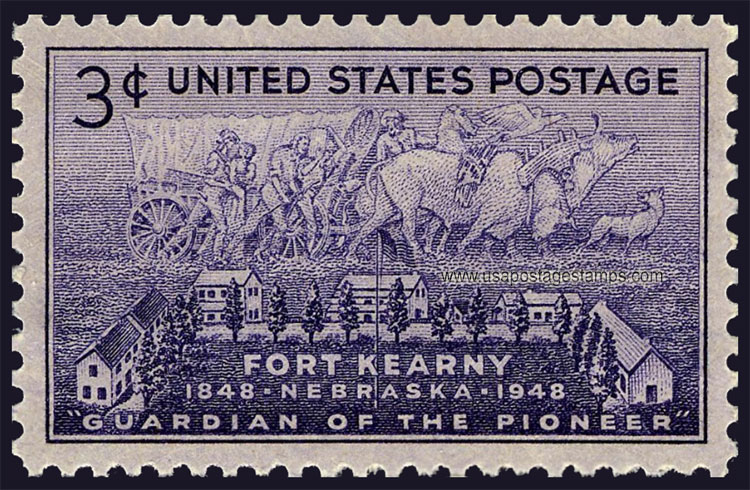US 1948 Fort Kearny and Pioneer Group 3c. Scott. 970

Series: Fort Kearny Issue
Stamp details: Fort Kearny and Pioneer Group
Issued date: 22-09-1948 (dd/mm/yyyy)
Face value: 3c.
Emission: Commemorative
Watermark: No Watermark
Catalogue No:-
Scott (USA): 970
Stanley Gibbons (UK): 967
Michel (Germany): 583
Yvert et Tellier (France): 522
Dimensions (height x width):
25mm x 40mm
Printer: Bureau of Engraving and Printing
Print Method: Rotary Press
Stamp Colors: Violet
Perforation: Perf 11 x 10½
Themes: Horse, Dog, Animals, Wagon, Buildings
Total print: 58,332,000 (estimate)
Stamp details: Fort Kearny and Pioneer Group
Issued date: 22-09-1948 (dd/mm/yyyy)
Face value: 3c.
Emission: Commemorative
Watermark: No Watermark
Catalogue No:-
Scott (USA): 970
Stanley Gibbons (UK): 967
Michel (Germany): 583
Yvert et Tellier (France): 522
Dimensions (height x width):
25mm x 40mm
Printer: Bureau of Engraving and Printing
Print Method: Rotary Press
Stamp Colors: Violet
Perforation: Perf 11 x 10½
Themes: Horse, Dog, Animals, Wagon, Buildings
Total print: 58,332,000 (estimate)
Description:- Fort Kearny was a historic outpost of the United States Army founded in 1848 in the western U.S. during the middle and late 19th century. The fort was named after Col. and later General Stephen Watts Kearny. The outpost was located along the Oregon Trail near Kearney, Nebraska. The town of Kearney took its name from the fort. The "e" was added to Kearny by postmen who consistently misspelled the town name. A portion of the original site is preserved as Fort Kearny State Historical Park by the Nebraska Game and Parks Commission.
The fort became the eastern anchor of the Great Platte River Road and thus an important military and civilian way station for 20 years. Wagon trains moving west, were able to resupply after completing about a sixth (16%) of the journey. The fort offered a safe resting area for the eastern immigrants in this new and hostile land. Livestock could be traded for fresh stock and letters sent back to the States. The fort continued to expand over the years, until there were over 30 buildings before its closure in 1871. It took on additional roles as a Pony Express station, an Overland Stage station and a telegraph station.
Source: en.wikipedia.org/wiki/Fort_Kearny
The fort became the eastern anchor of the Great Platte River Road and thus an important military and civilian way station for 20 years. Wagon trains moving west, were able to resupply after completing about a sixth (16%) of the journey. The fort offered a safe resting area for the eastern immigrants in this new and hostile land. Livestock could be traded for fresh stock and letters sent back to the States. The fort continued to expand over the years, until there were over 30 buildings before its closure in 1871. It took on additional roles as a Pony Express station, an Overland Stage station and a telegraph station.
Source: en.wikipedia.org/wiki/Fort_Kearny




